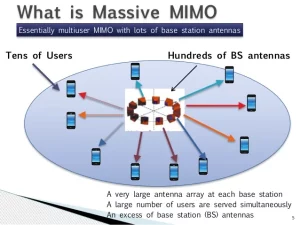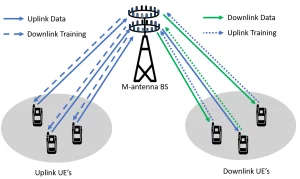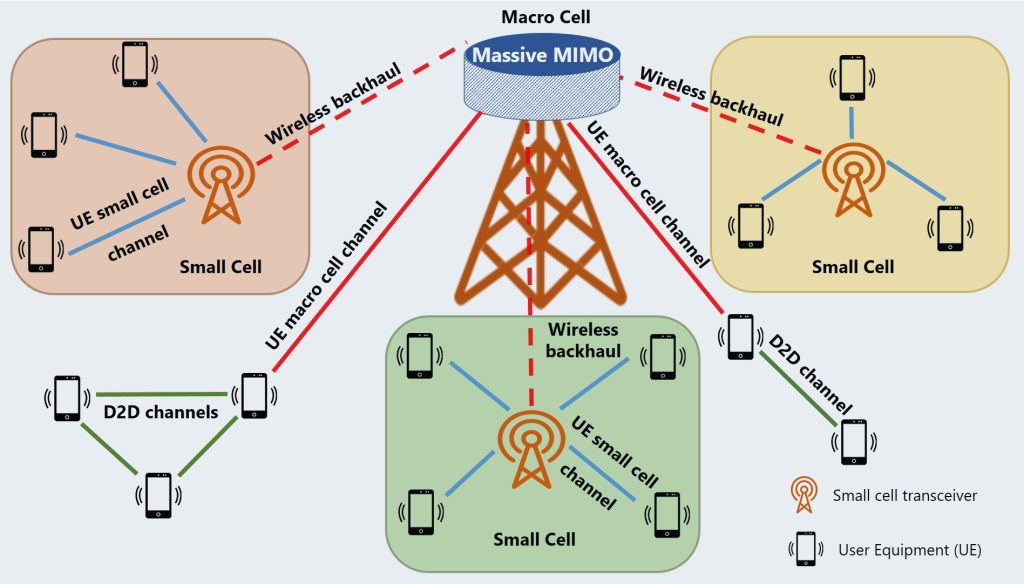The world of wireless communication has been utterly transformed by the advent of Massive MIMO technology, which has made it possible to transmit multiple data streams simultaneously. This cutting-edge approach relies on a vast number of antennas at both ends of the transmission to maximize spectral efficiency, or how much information can be sent over a given frequency spectrum. As a result, 5G networks have experienced an unprecedented surge in data rates and capacity while latency has plummeted.

However, achieving high spectral efficiency in Massive MIMO systems is no easy feat. Transmit power is one key factor that requires careful consideration since boosting it can improve signal strength and minimize interference between users. Additionally, uniform linear array gain plays an equally vital role in enhancing spectral efficiency by increasing antenna gain and directivity through closely spaced elements.
But these are only some of the factors that must be taken into account when seeking to augment uplink massive MIMO system efficiency. Channel estimation accuracy, pilot contamination mitigation techniques, optimal resource allocation schemes for uplink and downlink transmissions – all these demand meticulous attention as well as inter-cell interference coordination mechanisms for multi-cell massive MIMO system design if severe performance degradation due to co-channel interference from adjacent cells is to be avoided.
With global demand for high-speed wireless communication services continuing its meteoric ascent; efficient hardware design coupled with advanced digital signal processing algorithms like MMSE detector are absolutely critical components required for realizing practical implementation of Massive MIMO technology – truly bewildering stuff!
Improving Spectral Efficiency in Massive MIMO Systems by Increasing Transmit Power
Contents
- 1 Improving Spectral Efficiency in Massive MIMO Systems by Increasing Transmit Power
- 2 Uniform Linear Array Gain and Its Role in MIMO Systems
- 3 Achieving High Spectral Efficiency in Networks with Massive MIMO
- 4 Spectral Efficiency Analysis and Energy Efficiency of Massive MIMO Cellular Systems
- 5 Advanced Requirements for and Wireless Technology
- 6 Hardware Efficiency and MMSE Detector for Massive MIMO Systems
The enigma of spectral efficiency in massive MIMO systems can be achieved through a variety of methods, one of which is the augmentation of transmit power. This method enables an increase in signal-to-noise ratio (SNR) at the receiver and subsequently enhances link spectral efficiency. However, this path can lead to obstacles such as amplified energy consumption and interference with other users sharing the same frequency band.

Uniform linear arrays are essential components that contribute significantly toward improving spectral efficiency in MIMO systems. By collecting signals from various directions and amalgamating them into a single output signal, uniform linear array gain facilitates multiple beams’ creation that can be directed simultaneously towards different users. In turn, this helps augment capacity without necessitating additional infrastructure or spectrum.
5G networks require high spectral efficiency due to their support for higher data rates and more devices than previous cellular networks. Hence, massive MIMO technology plays a critical role in achieving these goals by providing greater spatial diversity while mitigating interferences between users. Furthermore, energy efficiency emerges as another crucial consideration when deploying large-scale massive MIMO systems featuring multiple antennas consuming more power than traditional cellular networks.
Uniform Linear Array Gain and Its Role in MIMO Systems
The significance of Uniform Linear Array (ULA) gain cannot be overstated in the realm of Multiple-Input Multiple-Output (MIMO) systems. MIMO technology is a wireless communication technique that employs multiple antennae at both ends to achieve remarkable spectral and energy efficiency. The ULA gain is an essential metric used to measure the antenna array’s ability to amplify transmission signals.
It’s worth noting that increasing transmit power alone does not always result in better throughput or data rates in MIMO systems due to interference from other networks’ signals. Instead, utilizing ULAs can alleviate this issue by enabling spatial reuse of spectrum and improving overall spectrum efficiency. This implies more users can enjoy high-quality connections without requiring additional bandwidth.
In cellular networks, where base stations must provide service to numerous users while maintaining adequate channel capacity and signal-to-noise ratio (SNR), ULAs are indispensable tools for managing interferences between different devices within their coverage area while maximizing available MHz for data transmission purposes. With 5G networks becoming increasingly ubiquitous worldwide, achieving optimal spectral efficiency will become critical for meeting surging demand for mobile data services.
Achieving High Spectral Efficiency in Networks with Massive MIMO
The perplexing and bursting world of wireless systems requires high spectral efficiency, which is where massive MIMO technology comes into play. This revolutionary approach has shown significant improvements in uplink performance by using multiple antennas at the base station to allow several user devices to transmit without impeding each other – thereby boosting area spectral efficiency.
But that’s not all! Downlink performance can also benefit immensely from these networks. By employing beamforming techniques, base stations can focus signals towards individual or clustered users, providing impressive spectral efficiencies even when serving a large number of devices simultaneously. And with advances in signal processing and 5G wireless technologies on the horizon, we anticipate further developments in this field.
Antenna systems like massive multiple-input and uniform linear arrays are essential for achieving high data rates and reliable connectivity in modern cellular networks – improving spectral efficiency is key here. Additionally, advanced receiver designs such as MMSE detectors help reduce power consumption while maintaining top-quality communication links between devices; hardware efficiency gains like these contribute significantly to energy conservation across all areas of operation.
As we continue exploring new ways to improve wireless technology’s energy efficiency through transmission protocols and network architecture design alike, there will undoubtedly be more exciting breakthroughs soon enough!
Spectral Efficiency Analysis and Energy Efficiency of Massive MIMO Cellular Systems
The utilization of massive MIMO technology in cellular systems has resulted in substantial enhancements to network capacity and area spectral efficiency. The link spectral efficiency of multi-cell massive MIMO systems is significantly influenced by the number of antennas at both the base station and user equipment, along with other channel characteristics. Thus, it is a pivotal task to optimize these parameters for attaining high levels of spectral and energy efficiency.
One approach to augmenting uplink massive MIMO efficiency involves boosting transmit power and uniform linear array gain. However, this technique also amplifies energy consumption, which must be managed thoughtfully for sustainability objectives. An alternate solution entails utilizing hardware-efficient algorithms like MMSE detectors that provide excellent performance while possessing low computational complexity.
As wireless access moves towards 5G technology, there arises an ever-growing demand for advanced requirements that foster high levels of spectral and energy efficiency. Research demonstrates that Massive MIMO systems are well-suited for fulfilling such demands due to their exceptional ability to handle large numbers of users simultaneously while maintaining supremely high data rates. These findings were presented at the International Conference on Communication where experts discussed various approaches aimed at achieving efficient Massive MIMO implementations suitable for 5G networks.\n
Advanced Requirements for and Wireless Technology
The evolution of wireless communication systems has been nothing short of remarkable in recent years. The emergence of massive multiple-input and multiple-output (MIMO) technology has captured the attention of industry experts as a means to achieve higher spectral efficiency. However, uplink 5G massive MIMO systems require ingenious detection algorithms to realize their full potential.
Spectral efficiency analysis is an essential evaluation criterion for wireless technology performance. The achievement of optimal spectral efficiency is a critical metric that outlines how efficiently data can be transmitted over a particular bandwidth. Enhanced spectral efficiency results in more data being transmitted per unit time or frequency, ultimately leading to better throughput rates and improved user experience.
Efficiency per area is another crucial aspect when it comes to evaluating wireless technology performance. Spectral and energy efficiencies are closely related since they both measure resource utilization levels for transmitting data effectively. Massive MIMO cellular system’s area energy efficiency plays a pivotal role in determining how much power would be needed to cover specific regions while maintaining top-quality service levels.
In conclusion, maximal spectral efficacy must always remain at the forefront while minimizing power consumption during the design phase- this makes energy-efficient designs all-important elements for future wireless networks!
Hardware Efficiency and MMSE Detector for Massive MIMO Systems
The development of energy-efficient massive MIMO systems hinges on the critical factor of hardware efficiency. The utilization of intelligent and advanced hardware components can result in significant enhancements in the overall efficiency of distributed antennas within such systems, ultimately leading to better spectral efficiency and higher throughput rates for wireless communication networks.
However, one must not overlook a crucial aspect that affects hardware efficiency: the MMSE detector for massive MIMO systems with imperfect channel state information (CSI). While MMSE-based detection has been proposed as an efficient method to mitigate interference and improve data rates for uplink 5G communication, this approach entails high computational complexity. To address this issue, optimized hardware design is required.
Moreover, when it comes to analyzing the efficacy of massive MIMO cellular systems’ efficiencies, a focus on hardware optimization becomes imperative. As antenna count increases and augmentation in massive MIMO systems takes place, there arises a pressing need for processing units that are more efficient at handling large volumes of data while simultaneously maintaining low power consumption levels. Thus, advanced requirements for 4G/5G wireless technology must be taken into account during the process of designing future generations’ mobile network’s hardware architecture.


